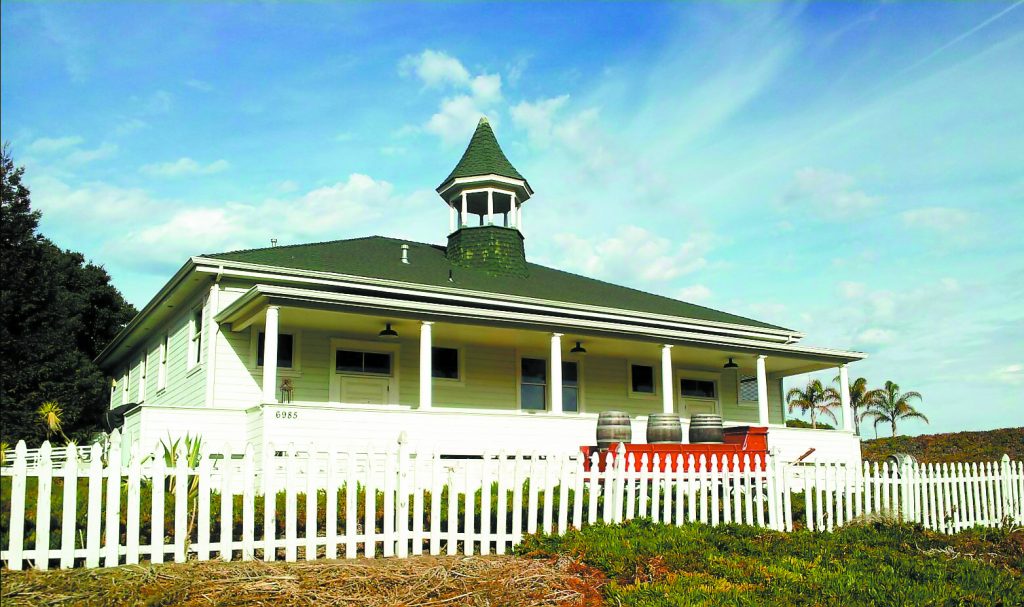By Betty Hartig
Perhaps as you have parked in the Bob Jones Pathway parking lot on Ontario Road to begin your hike, you have noticed the iconic schoolhouse adjacent to the northeast section of the parking area. For the past few months, there has been a bevy of activity occurring at this landmark building. Construction equipment could be seen coming and going. Banging, hammering, and sawing sounds could be heard. All the commotion was coming directly from the parking lot neighbor, the historic Santa Fe School. Trail users have been curious as to what is being transformed. But first, let us look at the history of this schoolhouse.
Well over a century ago, the Bob Jones Trail parking site was near Miles Station; at the time this was the end of the line for the Pacific Coast Railroad. The landowners and occupants of the area changed as time passed. It has been said that a cantina once occupied the vicinity. In early 1907, an additional school was built in the Avila Valley region to educate children from the expected 200 or so families that were arriving to work at the nearby Oil Port Refinery (what is now Sunset Palisades in Shell Beach).
That school became the Santa Fe School, currently located on the site. Contrary to belief, this two-room schoolhouse was not moved from another locality. It was built and remains at the present Ontario Road location. Several unforeseen circumstances and ultimately a fierce storm ended the life of the Oil Port wharf and the refinery in December 1907 before it even had a chance to get established. Despite this tragedy, the school remained open and served the community continuously until 1964.
Children who attended the Santa Fe School were from the Cave Landing, Miles Station, and other Avila Valley locales. The school was equipped with blackboards, desks, and books for the two classrooms. The girls wore knee-length dresses and often adorned a large ribbon in their hair. Most of the boys scampered to school wearing overalls. The pupils were taught the primary subjects, which were the three R’s, reading, writing, and arithmetic. Although the writing instruments and books have changed, 2+2 still equals 4. As common with most rural schools, the teacher would instruct students of various ages and abilities. Avila Valley had an abundant population of children, which enabled the educational institution to keep functioning for many years, but alas, in 1964, its purpose as a schoolhouse came to an end.
Over the years, the schoolhouse has had a variety of owners and uses, including a martial arts studio and single-family residence. Eventually, the school fell into disrepair.
LEFT: In early 1907 the schoolhouse was built in the Avila Valley region to educate children from the expected 200 or so families that were arriving to work at the nearby Oil Port Refinery which later fell into disrepair. Contributed photo
RIGHT: After several years, today the original wood floors will once again have the patter of little feet as history goes full circle and the schoolhouse returns to being a school. Photo by Betty Hartig
In 2000 John Salisbury purchased the school, and massive restoration was undertaken. The building frame, wooden floors, wainscot molding, and chalkboards are original. After the renovations were completed, the schoolhouse was used as a wine tasting facility.
The dust has now settled from the Bob Jones Trail parking lot neighbor. The Santa Fe School has a new facelift, but the floor plan remains the same.
Parking and landscaping improvements have been made. New playground equipment has been added. You will once again hear little ones playing. Young children will be back in the schoolhouse learning, exploring, and making new friends. Most likely, by the time this article prints, the Little Sprouts Avila Infant and Toddler Care will be open and ready to welcome its first enrollees.
It is good to know that the schoolhouse history has not been lost. Changes have been made, but the historical value remains. In the day and age when many buildings are torn down for new tenants, it is a pleasure to see that this esteemed Avila Beach schoolhouse is being preserved. Local historians continue the effort to obtain historical designation for this important Santa Fe School. It is far from abandonment. The original wood floors will once again have the patter of little feet as history goes full circle and the schoolhouse returns to being a school.








